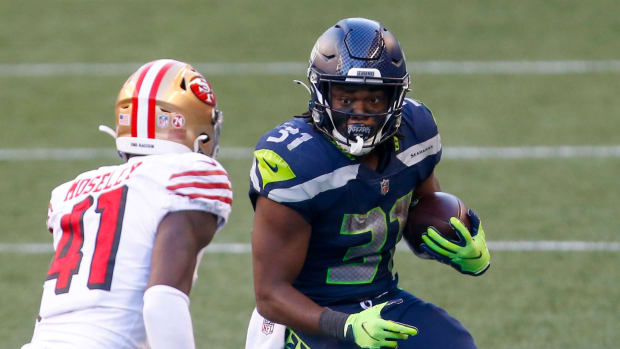Travis Homer Proving to Be Excellent Day 3 Pick for Seahawks
Seahawks running back Travis Homer is already an example of effective day three drafting early into his NFL career. Homer was hotly talked about on the infamous Seahawks twitter after Seattle’s Sunday Night Football win over the Minnesota Vikings. The Archduke Franz Ferdinand moment was provided by, um, me:
Taken in the sixth round of the 2019 draft, Homer has proven himself to be a valuable contributor on offense and via special teams. Measuring 5-foot-10 and weighing 201 pounds at the combine, Homer ran a 4.48 second 40-yard dash (78th percentile), leapt 39.5 inches vertically (91st percentile), and jumped 130” in the broad (96th percentile). He also put up 17 reps on the bench press. These numbers have shown up in the Miami product’s play with Seattle.
A lot of the frustration with Homer stems from the 22-year-old being underwhelming with the ball in his hands. Indeed, Homer will not be making highlight reels. From a raw box score viewing, Homer stacks up fine behind Chris Carson in Seattle’s running back production.
- Chris Carson - 289 rushing yards, 4.7 yards per carry, three rushing touchdowns
- Carlos Hyde - 57 rushing yards on 16 attempts, 3.6 yards per carry, one rushing touchdown
- Travis Homer – 58 rushing yards on 15 attempts, 3.9 yards per carry. zero rushing touchdowns
Looking at EPA, though, is less kind to Homer’s performance. Homer has a -9.4 figure, while Hyde has a -2.9. Most of this is Homer not receiving the plays to boost this figure, but also lacking the ability to generate yards by running someone over or making them miss with agility. While Hyde has caught three passes for 26 receiving yards, Homer has caught three passes for just seven yards - although one of those was a touchdown catch versus Miami.
The analytics community has proven that "running backs don’t matter," that backs are ultra reliant on the offensive line ability and play call. Homer is a good example of this dependency. Homer has suffered from missed blocks that came on wide run tosses -big negative plays - and his receptions have come with him being the check down in the pattern. None of this is his fault.
It makes sense that Homer is also behind Hyde in the snap count usage too. Homer is a change-of-pace runner who carries the ball with a style distinctly different to Carson or Hyde. Homer’s main positive as a runner is his above average vision, which is particularly noticeable when finding outside zone creases.
| Week | Chris Carson | Carlos Hyde | Travis Homer |
|---|---|---|---|
Week 1 vs. Falcons | Offense: 45% Special Teams 0% | Offense: 34% Special Teams 0% | Offense: 21% Special Teams 66% |
Week 2 vs. Patriots | Offense: 63% Special Teams 0% | Offense: 24% Special Teams 0% | Offense: 13% Special Teams 64% |
Week 3 vs. Cowboys | Offense: 58% Special Teams 0% | Offense: 21% Special Teams 0% | Offense: 21% Special Teams 70% |
Week 4 vs. Dolphins | Offense: 56% Special Teams 0% | Did Not Play | Offense: 27% Special Teams 58% |
Week 5 vs. Vikings | Offense: 57% Special Teams 0% | Did Not Play | Offense: 43% Special Teams 72% |
As you can see in the chart above, Homer is getting a ton of special teams action. He plays on most of the units, covering kicks while also being able to return them and help with punt protection. The reason Homer played more against Minnesota was because Carlos Hyde was missing and DeeJay Dallas had a few shaky moments in pass protection versus Miami.
That win over the Dolphins was the real coming out party for Homer’s best element: his pass protection ability. Miami sent a bunch of pressure which required Seattle to keep the back in. As a passing down and two minute drill back, there is no one better than Homer for the Seahawks.
Homer is versatile, reliable, and talented in this area. He can be a sniffer versus sugared A-gaps, he can check-and-release, he can scan, he can full slide. All of the things that defenses like to employ versus the Seattle offense, Homer can be used as a valuable piece to combat this. It’s clear he has benefitted from focusing on this role and there is a noticeable difference in the pass protection when he is on the field. The Seahawks are able to run a variety of protection schemes as a result.
In the video at the top of the article, I supercut of Homer’s 2020 pass protection reps so that you can see for yourself, rather than citing PFF numbers or relying on hazy broadcast recollection. I’ve omitted check-and-release reps where Homer correctly released cleanly downfield.
Homer getting the odd carry as a tendency breaker that keeps defenses honest is a fine trade off for his protection ability, especially when you factor in his vision and the low value/environmental dependency of running backs in general. The better yards per carry of Homer compared to Hyde reflects this.
Kansas City's recent signing of Le'Veon Bell demonstrates the importance of having a reliable third down back. Even with the first rounder spent on Clyde Edwards-Helaire, Kansas City clearly felt they needed a player well-versed in pass pro as well as routes.
For Seattle, the significance of having Homer’s excellent pass pro from the position is particularly strong in this #LetRussCook, pass-heavy attack. Combined with his special teams play, Homer is a valuable contributor and proving to be an excellent day three pick, one who takes up just 0.4 percent of the cap in 2020. This is how winning football teams are built - supplement elite talent with cheap but effective multi-role players.




